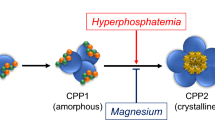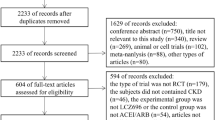Abstract
Background
Cardiovascular disease, and mainly coronary heart disease (CHD), is the leading cause of death in hemodialysis (HD) patients. Non-traditional risk factors may play an important role in this population. Arginase is known to contribute directly to atherosclerosis progression and to counteract the beneficial effects of nitric oxide. HD could be considered as an inflammatory condition. Inflammation contributes to atherosclerosis progression and influences both arginase and nitric oxide synthase expression. In the present study, serum arginase type I was evaluated as a marker of CHD in HD patients. The markers of inflammation interleukin-6 (IL-6) and tumor necrosis factor-alpha (TNF-α) were also assessed.
Patients and methods
Sixty-eight HD patients and 24 healthy volunteers were enrolled into the study. Twenty HD patients suffered from CHD confirmed with coronary angiography, while the remaining 48 HD patients were asymptomatic. Serum arginase type I, IL-6 and TNF-α were measured with ELISA. During 24 months follow-up, none of the asymptomatic subjects developed symptoms of CHD.
Results
IL-6 and TNF-α levels were increased in HD patients, but did not differ between HD patients with or without CHD. On the contrary, arginase levels did not differ between healthy subjects and HD patients, but were twice higher in HD patients with CHD than in HD patients without CHD (22.41 ± 15.47 ng/ml vs. 10.16 ± 8.13 ng/ml).
Conclusion
Arginase type I may contribute to the pathogenesis of CHD in HD patients and its serum levels could be used as a marker of CHD in this population.



Similar content being viewed by others
References
Tonelli M, Wiebe N, Culleton B, House A, Rabbat C, Fok M, McAlister F, Garg AX (2006) Chronic kidney disease and mortality risk: a systematic review. J Am Soc Nephrol 17:2034–2047
Parfrey PS, Foley RN (1999) The clinical epidemiology of cardiac disease in chronic renal failure. J Am Soc Nephrol 10:1606–1615
Kalantar-Zadeh K, Block G, Humphreys MH, Kopple JD (2003) Reverse epidemiology of cardiovascular risk factors in maintenance dialysis patients. Kidney Int 63:793–808
Levin NW, Handelman GJ, Coresh J, Port FK, Kaysen GA (2007) Reverse epidemiology: a confusing, confounding, and inaccurate term. Semin Dial 20:586–592
Paraskevas KI, Kotsikoris I, Koupidis SA, Tzovaras AA, Mikhailidis DP (2010) Cardiovascular events in chronic dialysis patients: emphasizing the importance of vascular disease prevention. Int Urol Nephrol. doi:10.1007/s11255-010-9795-7
Bhan I, Thadhani R (2009) Vascular calcification and ESRD: a hard target. Clin J Am Soc Nephrol 4(Suppl 1):S102–S105
Patsalas S, Eleftheriadis T, Spaia S, Theodoroglou H, Antoniadi G, Liakopoulos V, Passadakis P, Vayonas G, Vargemezis V (2007) Thirty-month follow-up of coronary artery calcification in hemodialysis patients: different roles for inflammation and abnormal calcium-phosphorous metabolism? Ren Fail 29:623–629
Patsalas S, Eleftheriadis T, Spaia S, Theodoroglou H, Panou E, Liakopoulos V, Antoniadi G, Passadakis P, Vayonas G, Kanakis E, Vargemezis V (2005) The value of computed tomography-derived coronary artery calcification score in coronary artery disease detection in asymptomatic hemodialysis patients. Ren Fail 27:683–688
Ogawa T, Ishida H, Akamatsu M, Matsuda N, Fujiu A, Ito K, Ando Y, Nitta K (2010) Progression of aortic arch calcification and all-cause and cardiovascular mortality in chronic hemodialysis patients. Int Urol Nephrol 42:187–194
Zoccali C, Bode-Boger S, Mallamaci F, Benedetto F, Tripepi G, Malatino L, Cataliotti A, Bellanuova I, Fermo I, Frolich J, Boger R (2001) Plasma concentration of asymmetrical dimethylarginine and mortality in patients with end-stage renal disease: a prospective study. Lancet 358:2113–2117
Chicoine LG, Paffett ML, Young TL, Nelin LD (2004) Arginase inhibition increases nitric oxide production in bovine pulmonary arterial endothelial cells. Am J Physiol Lung Cell Mol Physiol 287:L60–L68
Lee J, Ryu H, Ferrante RJ, Morris SM Jr, Ratan RR (2003) Translational control of inducible nitric oxide synthase expression by arginine can explain the arginine paradox. Proc Natl Acad Sci U S A 100:4843–4848
Prabhakar SS, Zeballos GA, Montoya-Zavala M, Leonard C (1997) Urea inhibits inducible nitric oxide synthase in macrophage cell line. Am J Physiol 273:C1882–C1888
Boger RH, Bode-Boger SM (2000) Asymmetric dimethylarginine, derangements of the endothelial nitric oxide synthase pathway, and cardiovascular diseases. Semin Thromb Hemost 26:539–545
Palmer RM, Ferrige AG, Moncada S (1987) Nitric oxide release accounts for the biological activity of endothelium-derived relaxing factor. Nature 327:524–526
Ignarro LJ, Buga GM, Wood KS, Byrns RE, Chaudhuri G (1987) Endothelium-derived relaxing factor produced and released from artery and vein is nitric oxide. Proc Natl Acad Sci U S A 84:9265–9269
Kubes P, Suzuki M, Granger DN (1991) Nitric oxide: an endogenous modulator of leukocyte adhesion. Proc Natl Acad Sci U S A 88:4651–4655
Zeiher AM, Fisslthaler B, Schray-Utz B, Busse R (1995) Nitric oxide modulates the expression of monocyte chemoattractant protein 1 in cultured human endothelial cells. Circ Res 76:980–986
Tanner FC, Meier P, Greutert H, Champion C, Nabel EG, Luscher TF (2000) Nitric oxide modulates expression of cell cycle regulatory proteins: a cytostatic strategy for inhibition of human vascular smooth muscle cell proliferation. Circulation 101:1982–1989
Cornwell TL, Arnold E, Boerth NJ, Lincoln TM (1994) Inhibition of smooth muscle cell growth by nitric oxide and activation of cAMP-dependent protein kinase by cGMP. Am J Physiol 267:C1405–C1413
Moro MA, Russel RJ, Cellek S, Lizasoain I, Su Y, Darley-Usmar VM, Radomski MW, Moncada S (1996) cGMP mediates the vascular and platelet actions of nitric oxide: confirmation using an inhibitor of the soluble guanylyl cyclase. Proc Natl Acad Sci U S A 93:1480–1485
Trepakova ES, Cohen RA, Bolotina VM (1999) Nitric oxide inhibits capacitative cation influx in human platelets by promoting sarcoplasmic/endoplasmic reticulum Ca2+-ATPase-dependent refilling of Ca2+ stores. Circ Res 84:201–209
Durante W, Liao L, Peyton KJ, Schafer AI (1998) Thrombin stimulates vascular smooth muscle cell polyamine synthesis by inducing cationic amino acid transporter and ornithine decarboxylase gene expression. Circ Res 83:217–223
Endean ED, Kispert JF, Martin KW, O’Connor W (1991) Intimal hyperplasia is reduced by ornithine decarboxylase inhibition. J Surg Res 50:634–637
Durante W, Liao L, Reyna SV, Peyton KJ, Schafer AI (2001) Transforming growth factor-beta(1) stimulates l-arginine transport and metabolism in vascular smooth muscle cells: role in polyamine and collagen synthesis. Circulation 103:1121–1127
Galkina E, Ley K (2009) Immune and inflammatory mechanisms of atherosclerosis (*). Annu Rev Immunol 27:165–197
Zimmermann J, Herrlinger S, Pruy A, Metzger T, Wanner C (1999) Inflammation enhances cardiovascular risk and mortality in hemodialysis patients. Kidney Int 55:648–658
Eleftheriadis T, Antoniadi G, Liakopoulos V, Kartsios C, Stefanidis I (2007) Disturbances of acquired immunity in hemodialysis patients. Semin Dial 20:440–451
MacNaul KL, Hutchinson NI (1993) Differential expression of iNOS and cNOS mRNA in human vascular smooth muscle cells and endothelial cells under normal and inflammatory conditions. Biochem Biophys Res Commun 196:1330–1334
Heo SK, Yun HJ, Noh EK, Park WH, Park SD (2008) LPS induces inflammatory responses in human aortic vascular smooth muscle cells via Toll-like receptor 4 expression and nitric oxide production. Immunol Lett 120:57–64
Gross SS, Jaffe EA, Levi R, Kilbourn RG (1991) Cytokine-activated endothelial cells express an isotype of nitric oxide synthase which is tetrahydrobiopterin-dependent, calmodulin-independent and inhibited by arginine analogs with a rank-order of potency characteristic of activated macrophages. Biochem Biophys Res Commun 178:823–829
Nelin LD, Nash HE, Chicoine LG (2001) Cytokine treatment increases arginine metabolism and uptake in bovine pulmonary arterial endothelial cells. Am J Physiol Lung Cell Mol Physiol 281:L1232–L1239
Durante W (2001) Regulation of l-arginine transport and metabolism in vascular smooth muscle cells. Cell Biochem Biophys 35:19–34
Jenkinson CP, Grody WW, Cederbaum SD (1996) Comparative properties of arginases. Comp Biochem Physiol B Biochem Mol Biol 114:107–132
Yasuda K, Okuda K, Endo N, Ishiwatari Y, Ikeda R, Hayashi H, Yokozeki K, Kobayashi S, Irie Y (1995) Hypoaminotransferasemia in patients undergoing long-term hemodialysis: clinical and biochemical appraisal. Gastroenterology 109:1295–1300
Boulanger CM, Vanhoutte PM (1997) G proteins and endothelium-dependent relaxations. J Vasc Res 34:175–185
Nishida K, Harrison DG, Navas JP, Fisher AA, Dockery SP, Uematsu M, Nerem RM, Alexander RW, Murphy TJ (1992) Molecular cloning and characterization of the constitutive bovine aortic endothelial cell nitric oxide synthase. J Clin Invest 90:2092–2096
Bachetti T, Comini L, Francolini G, Bastianon D, Valetti B, Cadei M, Grigolato P, Suzuki H, Finazzi D, Albertini A, Curello S, Ferrari R (2004) Arginase pathway in human endothelial cells in pathophysiological conditions. J Mol Cell Cardiol 37:515–523
Berka V, Wu G, Yeh HC, Palmer G, Tsai AL (2004) Three different oxygen-induced radical species in endothelial nitric-oxide synthase oxygenase domain under regulation by l-arginine and tetrahydrobiopterin. J Biol Chem 279:32243–32251
Eleftheriadis T, Kartsios C, Yiannaki E, Kazila P, Antoniadi G, Liakopoulos V, Markala D (2008) Chronic inflammation and T cell zeta-chain downregulation in hemodialysis patients. Am J Nephrol 28:152–157
Eleftheriadis T, Kartsios C, Yiannaki E, Kazila P, Antoniadi G, Liakopoulos V, Markala D (2008) Chronic inflammation and CD16+ natural killer cell zeta-chain downregulation in hemodialysis patients. Blood Purif 26:317–321
De Vriese AS, Verbeuren TJ, Van de Voorde J, Lameire NH, Vanhoutte PM (2000) Endothelial dysfunction in diabetes. Br J Pharmacol 130:963–974
Rask-Madsen C, King GL (2007) Mechanisms of disease: endothelial dysfunction in insulin resistance and diabetes. Nat Clin Pract Endocrinol Metab 3:46–56
Kannel WB, McGee DL (1979) Diabetes and cardiovascular risk factors: the Framingham study. Circulation 59:8–13
Grundy SM, Pasternak R, Greenland P, Smith S Jr, Fuster V (1999) Assessment of cardiovascular risk by use of multiple-risk-factor assessment equations: a statement for healthcare professionals from the American Heart Association and the American College of Cardiology. Circulation 100:1481–1492
Longenecker JC, Coresh J, Powe NR, Levey AS, Fink NE, Martin A, Klag MJ (2002) Traditional cardiovascular disease risk factors in dialysis patients compared with the general population: the CHOICE Study. J Am Soc Nephrol 13:1918–1927
Devaraj S, Dasu MR, Jialal I (2010) Diabetes is a proinflammatory state: a translational perspective. Expert Rev Endocrinol Metab 5:19–28
Author information
Authors and Affiliations
Corresponding author
Rights and permissions
About this article
Cite this article
Eleftheriadis, T., Liakopoulos, V., Antoniadi, G. et al. Arginase type I as a marker of coronary heart disease in hemodialysis patients. Int Urol Nephrol 43, 1187–1194 (2011). https://doi.org/10.1007/s11255-010-9842-4
Received:
Accepted:
Published:
Issue Date:
DOI: https://doi.org/10.1007/s11255-010-9842-4




